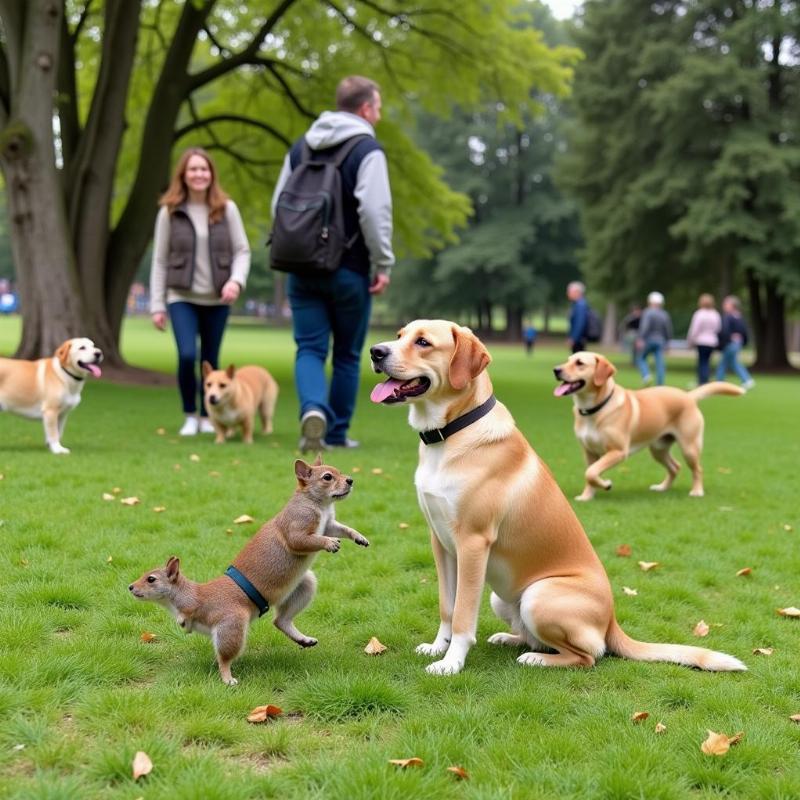The 3 D’s of dog training – Distance, Duration, and Distraction – are fundamental concepts that every dog owner in the US should understand. These principles are crucial for building a strong foundation for obedience, shaping desired behaviors, and fostering a positive relationship with your canine companion. Whether you’re a seasoned dog owner or just starting out, understanding and applying the 3 D’s will significantly impact your training journey and help you achieve remarkable results.
Understanding Distance in Dog Training
Distance in dog training refers to the physical space between you and your dog while executing a command. Initially, you’ll work with your dog very close, gradually increasing the distance as they become more proficient. This gradual progression allows your dog to solidify the learned behavior before adding complexity. Think of it like learning to ride a bike with training wheels – you start with the extra support and slowly remove it as your balance improves. Starting with short distances builds confidence and sets your dog up for success. Imagine teaching your dog “stay.” You would begin with your dog right in front of you, gradually taking a step or two back as they hold the stay. Over time, you’ll be able to increase the distance significantly.
Mastering Duration in Dog Training
Duration refers to the length of time your dog can maintain a behavior. Just as with distance, start small and gradually increase the duration. Asking your dog to “stay” for one second is much easier than asking for a five-minute hold. As they succeed with shorter durations, slowly increase the time. This progressive approach prevents frustration and encourages learning. Consistent practice and positive reinforcement are key to extending the duration of desired behaviors. Reward your dog frequently for holding the behavior, even for short periods, to reinforce their understanding and build their stamina.
Conquering Distraction in Dog Training
Distraction is arguably the most challenging of the 3 D’s. It involves training your dog to perform commands amidst distractions like other dogs, people, or enticing smells. Start by introducing minor distractions in controlled environments and gradually increase the level of difficulty as your dog progresses. For example, begin training “stay” in a quiet room, then move to the backyard, and eventually to a busy park. Successful distraction training hinges on building a strong foundation in distance and duration. A dog who can reliably perform a command at a distance and for a sustained duration is better equipped to handle distractions.
 Dog training overcoming distractions
Dog training overcoming distractions
Applying the 3 D’s Together
While each “D” is important individually, the real power comes from combining them. Once your dog understands a command at close range, for short periods, and without distractions, you can start to integrate the 3 D’s. For example, you might ask your dog to “stay” while you walk a few steps away (distance), hold the stay for a few seconds (duration), and then reward them while a friend walks by (distraction). Remember to progress gradually and always set your dog up for success.
Conclusion
Mastering the 3 D’s of dog training—Distance, Duration, and Distraction—is essential for effective communication and building a well-behaved canine companion. By understanding and applying these principles, you’ll not only achieve better training outcomes but also strengthen your bond with your furry friend. Remember to be patient, consistent, and positive, and celebrate each milestone along the way!
FAQ
- How do I start with distance training? Start very close to your dog and gradually increase the distance as they become proficient.
- What if my dog breaks the “stay” command during duration training? Reduce the duration and try again. Don’t get discouraged!
- What are some common distractions to use in training? Start with minor distractions like toys or another person in the room and gradually increase the intensity to include other dogs, noises, or enticing smells.
- Can I use treats during distraction training? Yes, treats can be a valuable tool to motivate your dog and reinforce desired behaviors.
- How long does it take to master the 3 D’s? Every dog learns at their own pace. Be patient and consistent, and celebrate each small victory.
Beautdogs.us is your premier resource for all things dog-related in the US. We offer expert advice on dog breeds, care, training, and product recommendations for both new and experienced dog owners. For personalized guidance or to learn more about our services, reach out to our team at [email protected] or call us at +1 501-555-7529. Beautdogs.us is committed to helping you and your furry friend live a happy and fulfilling life together.